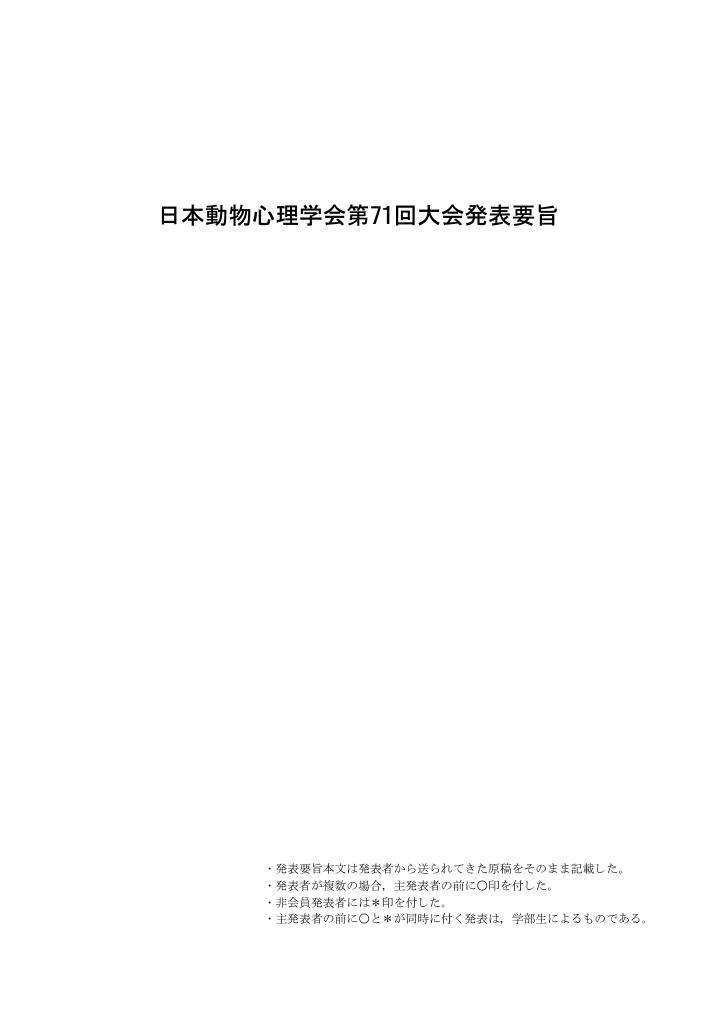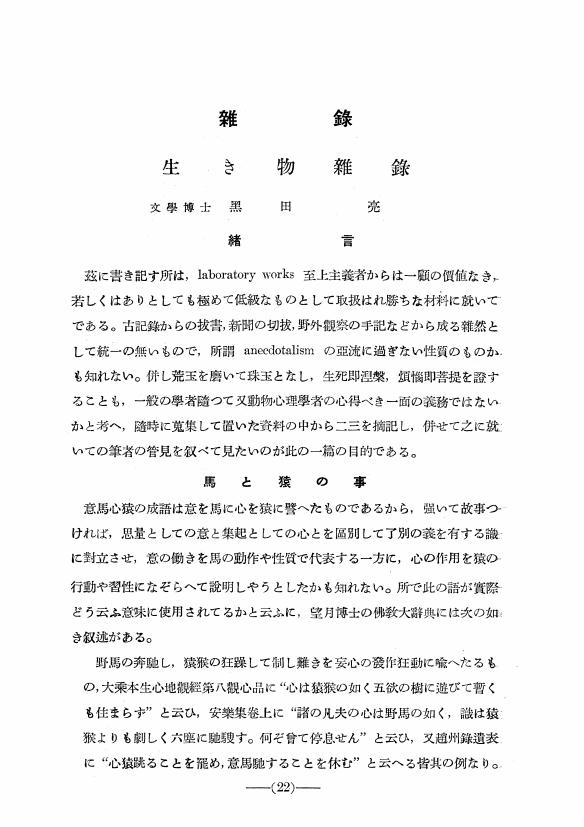1 0 0 0 Complexity of mutual communication in animals exemplified by paired dances in the red-crowned crane
- 著者
- F. TAKEDA KOHEI KUTSUKAKE NOBUYUKI
- 出版者
- 日本動物心理学会
- 雑誌
- 動物心理学研究
- 巻号頁・発行日
- 2018
- 被引用文献数
- 3
<p>Non-human animals commonly perform mutual communication in which two individuals simultaneously exchange information in an interaction that can comprise multiple components and multimodal signals. The forms of mutual communication vary widely, ranging from simple greeting ceremonies to complex paired dances including ultiple behavioural elements. Our understanding of mutual communication lags markedly because few systematic studies have examined this topic. In this review, we used the example of paired dances in red-crowned cranes (<i>Grus japonensis</i>) to examine two important aspects of mutual communication: structure and function. We reviewed the difficulty analysing the key characteristics of structure quantitatively (e.g. sequential pattern and complexity), and examined suitable analytic methods such as etermining the four levels of its characteristics. We proposed that a combination of current methods and new methods, such as the Shannon entropy index and temporal associations among behavioural elements, is necessary to quantify the complexity of mutual communication. Regarding the function of paired dances, we critically discuss the pair bond hypothesis, which suggests that a paired dance strengthens pair bonds in monogamous, long-living birds. Testing this classical hypothesis remains a challenge due to the difficulty of performing quantitative analyses of paired dances and the ambiguous concept of pair bonds. We hope that the questions and predictions raised in this paper will encourage future research on mutual communication in non-human animals.</p>
1 0 0 0 OA 野外における野生のハトのオペラント条件づけ
- 著者
- 藤 健一
- 出版者
- 日本動物心理学会
- 雑誌
- 動物心理学研究 (ISSN:09168419)
- 巻号頁・発行日
- vol.52, no.1, pp.9-14, 2002-06-25 (Released:2011-03-14)
- 参考文献数
- 19
野外の自然場面における野生のハトを対象として, オペラント条件づけを試みた。1つの反応キーと1つの強化子提示用のフィーダとを備えた野外用スキナー箱を使用した。飛来する野生のハトを対象として, 漸次接近法によるキーつつき反応の形成を試みた。さらにキーつつき反応を獲得した個体と未獲得の個体との行動上の相互作用について, 検討した。FRサイズが1から40までの定率強化スケジュールを用いた。強化子には, 市販のハト用混合飼料を用いた。飛来する野生のハトの個体識別を, 目視や写真を利用して行なった。実験期間は, 3月から7月にかけての84日間89セッションであった。実験の結果, この期間中のハトの延べ飛来数は628羽, 同定できた個体数は29羽であった。実験者によって2羽の個体が選定され, その個体に対して漸次接近法によるキーつつき反応の形成を行なった。その結果, 1羽は反応形成訓練開始から4セッションめにおいて, もう1羽は3セッションめにおいてキーつつき反応を自発するようになった。漸次接近法による反応形成訓練を受けていない個体の中で, 7個体がキーつつき反応を自発させた。このうちの2羽が, キーつつき反応を維持した。キーつつき反応を形成したハトに対して, 定率強化スケジュールのFR値を徐々に40まで増大させたところ, それぞれのFR値の下で安定した反応を示した。キーつつき反応を維持した個体のうち, 1羽はつがいで飛来していた。そのつがいの2羽のうち, 1羽は常にキーつつきを行い, もう1羽が常に強化子を摂食した。このつがいによるキーつつき反応の累積反応記録は, 1個体の場合とほとんど違いが見いだされなかった。
- 著者
- ARII WATANABE
- 出版者
- 日本動物心理学会
- 雑誌
- 動物心理学研究 (ISSN:09168419)
- 巻号頁・発行日
- vol.67, no.1, pp.37-39, 2017 (Released:2017-06-29)
- 参考文献数
- 2
As you prepare an English presentation, your main focus should be on getting your message across to the audience effectively. Even if you do not have native-like proficiency in English, there are many other ways to make your presentation appealing. These include learning and practicing pronunciation of keywords, adopting spoken language rather than written language for your speech, increasing the readability of your slides by reducing the amount of words on them, developing a relationship with the audience, and providing variation to keep the audience attentive. It should also be noted that language and presentation style have changed over the years and will continue to change.
1 0 0 0 OA マウスの養育行動に対する初期成育環境における雄親との同居の影響
- 著者
- 昌子 浩孝 加藤 克紀
- 出版者
- 日本動物心理学会
- 雑誌
- 動物心理学研究 (ISSN:09168419)
- 巻号頁・発行日
- vol.53, no.2, pp.45-55, 2003 (Released:2008-01-16)
- 参考文献数
- 23
The effects of male parents on later parental behavior of their pups were investigated in ICR mice. Male parents were vasectomized to prevent female parents from giving birth to the second litter before weaning of the first one. The subjects were reared by a female parent alone or by both parents until 30 days old. When they were exposed to stimulus pups at 10-11 weeks of age (Exp. 1), their parental behaviors didn't differ from each other for their rearing conditions. However, when they were tested after experiencing copulation (Exp. 2), nest-building significantly decreased in the females reared by both parents. These results suggest that in mice the effects of cohabitation with a male parent in the early rearing environment on parental behavior were modifiable by the experience of copulation, but such effects were largely limited.
1 0 0 0 OA 環境化学物質の発達神経毒性研究における動物心理学の役割
- 著者
- 宮川 宗之 小川 園子
- 出版者
- 日本動物心理学会
- 雑誌
- 動物心理学研究 (ISSN:09168419)
- 巻号頁・発行日
- vol.61, no.1, pp.9-13, 2011 (Released:2011-07-15)
- 参考文献数
- 11
This article describes background information for the symposium held at the 70th Annual meeting of the Japanese Society for Animal Psychology. The main theme of this symposium was to provide updated information on neurodevelopmental toxicity caused by environmental chemicals, through lectures by three distinguished researchers, and to discuss possible contributions and expected roles of animal psychology in toxicological studies designed to protect children's health. The Ministry of the Environment has commenced a large-scale, long-term epidemiological study entitled the “Environment and Children's Study (Eco-Chil)”, to elucidate health effects caused by chemical exposures of children including pervasive developmental disorders. Neurobehavioral assessments have been included in globally accepted guidelines for neurotoxicity and reproductive toxicity studies in rodents as effective tools for collecting experimental evidence. Findings from these experiments provide a scientific basis for the epidemiological studies, like Eco-Chil. However, currently available behavioral testing methods are insufficient for detecting neurodevelopmental effects of environmental chemicals, especially for emotionality and social aspects of behavior. Appropriate animal behavioral models are needed to advance toxicological studies further. Animal psychologists could greatly contribute to the development of these animal models and the interpretation of behavioral test results.
1 0 0 0 梅岡義貴先生を偲んで
- 著者
- 大山 正
- 出版者
- 日本動物心理学会
- 雑誌
- 動物心理学研究 (ISSN:09168419)
- 巻号頁・発行日
- vol.56, no.1, pp.4-5, 2006-06-25
1 0 0 0 OA 霊長類における毛づくろいの互恵性に関する研究の展開
- 著者
- 上野 将敬
- 出版者
- 日本動物心理学会
- 雑誌
- 動物心理学研究 (ISSN:09168419)
- 巻号頁・発行日
- pp.66.2.3, (Released:2016-10-14)
- 参考文献数
- 118
- 被引用文献数
- 1
Many researchers have investigated why and how animals benefit from each other in a group. Grooming is considered as prosocial behavior in animal societies; the groomer expends time and energy costs, while the groomee receives hygienic and physiological benefits. Based on the reciprocal altruism hypothesis (Trivers, 1971), many researchers have investigated grooming behaviors in primate species. In primates, individuals exchange grooming for grooming or other social benefits (e.g., tolerance for food, agonistic support, or infant handling). Researchers have also established and modified models of grooming reciprocity. In future researches, it would be valuable to investigate the effects of affiliative elationships, soliciting behaviors, self-rewarding, inequity aversion, and partner choice and partner switching on prosocial behaviors.
1 0 0 0 OA 動物園で学ぶ野生動物の子育て
- 著者
- 中道 正之
- 出版者
- 日本動物心理学会
- 雑誌
- 動物心理学研究 (ISSN:09168419)
- 巻号頁・発行日
- vol.66, no.1, pp.23-27, 2016 (Released:2016-06-27)
- 参考文献数
- 10
Understanding maternal behavior and infant development of wild animals living in modern zoos is essential for zoos to achieve conservation which is one of their primary roles, including successful reproduction in captivity. Moreover, zoos could provide us with the opportunities to understand the diversity of mother-infant relationships among mammals. For example, like those in the wild, giraffe and black rhinoceros mothers in captivity show hider and follower types, respectively. Moreover, our detailed observations at zoos have shown that giraffe mothers tend to be very responsible for nursing interactions with their calves, whereas rhinoceros mothers have tolerant attitudes toward their calves. Unlike ungulates, infants of primates such as Japanese monkeys and gorillas spend most of their time in contact with their mothers during the early stages of development owing to their clinging abilities, which decrease with increasing infant age. Seeing zoo animals directly as well as learning of their behavior, based on behavioral studies on them would help zoo visitors develop an interest in zoo animals and their counterparts in the wild.
1 0 0 0 OA 大型類人猿の母子の絆:チンパンジーとオランウータンにおける母子関係と認知発達
- 著者
- 林 美里
- 出版者
- 日本動物心理学会
- 雑誌
- 動物心理学研究 (ISSN:09168419)
- 巻号頁・発行日
- vol.66, no.1, pp.29-37, 2016 (Released:2016-06-27)
- 参考文献数
- 69
- 被引用文献数
- 2
Great apes have prolonged dependent period and learn a variety of skills and knowledge through intensive interaction with the mother based on affectionate bond between them. Among four species of great apes, both chimpanzees and orangutans use tools in the wild based on their skills of object manipulation and cognitive development which is gradually formed through mother-infant interactions. Researchers found the effectiveness of human intervention and support to promote mother-rearing in captive great apes despite of initial maternal problems. Compared to African great apes, orangutans have solitary lifestyle and the longest dependent period of about 7-8 years indicating the higher reliance on the other. Orang Utan Island (OUI) is a facility open to public and located in Bukit Merah, Perak, Peninsula Malaysia. OUI holds 26 orangutans and has been promoting rehabilitation program as an effort of ex-situ conservation. Orangutan mothers are now practicing infant rearing in OUI and in semi-natural environment in adjacent BJ Island. The importance of mother-infant interaction as a base for cognitive development should be widely recognized among animal researchers and keepers for promoting mother-rearing in captive settings.
1 0 0 0 OA ヒトにおける身体化された母子関係の発達
- 著者
- 根ケ山 光一
- 出版者
- 日本動物心理学会
- 雑誌
- 動物心理学研究 (ISSN:09168419)
- 巻号頁・発行日
- vol.66, no.1, pp.47-51, 2016 (Released:2016-06-27)
- 参考文献数
- 18
Both positivity and negativity are important components for the development of mother-offspring relationship. The "inter-body antagonism" is an important biological framework to promote offspring's independence from mothers. Weaning, an achievement of nutritional independence in offspring, is a typical situation in which mother-child negativity plays an important role. Human mother-child separation is also actualized by complex sociocultural allomothering systems consisting of objects, persons and institutes. Human triadic relationship in joint attention by mother and infant to object is a basic element of the systems. The relationship is preceded by "Proto-triadic relationship" in which particular body parts are used as targets in human inter-body interactions as in a case of tickling play.Not only object but also person could be a target of attention in triadic relation, and exchange of perspectives with the person is essential in the human infant's cultural learning and establishment of social network. A special allomothering by a girl called Moriane in an island of Okinawa is an example of such allomothering.
1 0 0 0 OA ウサギ, マウス, ラットにおける瞬目反射条件づけの神経回路
- 著者
- 坂本 敏郎
- 出版者
- 日本動物心理学会
- 雑誌
- 動物心理学研究 (ISSN:09168419)
- 巻号頁・発行日
- vol.66, no.1, pp.59-75, 2016 (Released:2016-06-27)
- 参考文献数
- 111
Eyeblink conditioning is an associative learning paradigm in which an association is formed by the paired presentation of a neutral conditioned stimulus (CS), such as a tone, and an unconditioned stimulus (US), such as a corneal air puff or a periorbital shock. In the rabbit, cerebellum-brainstem circuitry plays an essential role in delay eyeblink conditioning, in which the US is delayed and terminates simultaneously with the CS. However, the neural mechanisms underlying delay eyeblink conditioning in mice and rats are unclear. In addition to cerebellum-brainstem circuitry, the amygdala is reportedly important for delay eyeblink conditioning in the mouse and rat. Here, we review the neural mechanisms underlying delay eyeblink conditioning in the rabbit, mouse, and rat, discussing relevant neural circuitry specific to mice and rats versus rabbits. We also review the neural circuitry underlying trace eyeblink conditioning, in which the CS and US are separated by a stimulus-free trace interval. The forebrain and cerebellar-brainstem circuitries are important for trace eyeblink conditioning in the rabbit, mouse, and rat. This review provides useful information for future research on eyeblink conditioning and for understanding neural substrates subserving learning and memory.
- 著者
- 飯田 成敏 木村 裕
- 出版者
- 日本動物心理学会
- 雑誌
- 動物心理学研究 (ISSN:09168419)
- 巻号頁・発行日
- vol.54, no.2, 2004-12-25
1 0 0 0 IP023 ストレス緩衝作用に与えるパートナー恐怖状態の影響
1 0 0 0 OA 日本動物心理学会第71回大会発表要旨
- 出版者
- 日本動物心理学会
- 雑誌
- 動物心理学研究 (ISSN:09168419)
- 巻号頁・発行日
- vol.61, no.2, pp.187-249, 2011 (Released:2011-12-19)
- 著者
- 平尾 元尚
- 出版者
- 日本動物心理学会
- 雑誌
- 動物心理学研究 (ISSN:09168419)
- 巻号頁・発行日
- vol.46, no.2, 1996-12-25






